This is the first year I have grown my own potatoes. I bought seed potatoes, choosing Duke of York Earlies and cared for them whilst they chitted in egg boxes on the windowsill in my spare room.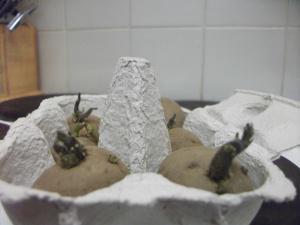
When the eyes were a couple of centimetres, I planted them in a potato bag. I even covered the sack with a wicker cloche to prevent animal damage, thinking a bag of soil could be great attraction to cats. As the foliage grew, I added more compost and another few chitted potatoes until the bag was full.
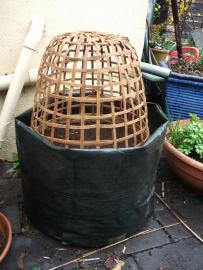
Pride comes before a fall. The wonderful looking growth, was lush and full of promise, until last week.
One evening, I noticed little freckles on some of the leaves. Initially I didn’t take much notice, not having grown potatoes before, it didn’t occur to me that it was a warning sign of a big problem looming.
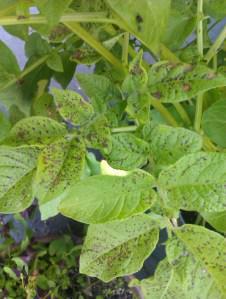
Almost overnight, all the leaves developed brown freckles and the horror that it could be potato blight hit me. I Goggled “blight”and took a photo which I posted on Twitter. Sure enough slowly the tweets arrived “looks like you have potato blight”. Garden Tweeters are great not only was I given lots of advice, I also learned that the name for vegetable foliage was haulm.
Potato Blight is caused by a fungus Phytophthora infestans. It spreads through the air and develops when the weather conditions are warm and humid and can happen overnight. We have had warm dry weather and last week the rain we have been desperately in need of arrived, creating the ideal condition for blight infection to occur. It is what caused the terrible famine in Ireland between 1845 and 1849 known as The Irish Potato Famine or The Great Hunger. These days potato growers use what is called Smith Periods which are defined as 2 consecutive days with temperatures of at least 10°C and 11 hours of relative humidity of 90% per day. There is a website called “Fight against Blight 2011″ where the Potato Council give regular blight alerts and advice on how to prevent it, as well as how to deal with it if you are unlucky enough to get it.
I could have used chemical treatments, such as Bordeaux Mixture, but I decided to cut away all the haulm and dispose of it. If I left it the leaves would have turned brown and the spores would have washed down to the tuber causing dark spots on the skin and reddish-brown stains on the potatoes. I was also advised to ensure that none of the foliage was put the compost heap, with burning being the best way of disposal.
There is a lot of information on the internet and most of it says that once the foliage is removed, you can leave the crop for at least two weeks to let the blight spores on the surface die. I decided to dig out what was there and not run the risk of losing all the potatoes. To be honest, there was also a tinge of excitement,
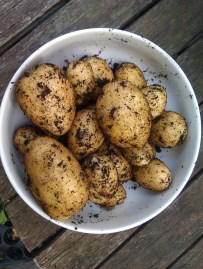
…REAL POTATOES, just like the ones you buy from the greengrocer – I had grown potatoes! “So what“, some might say, “I grow potatoes every year, no big deal” but this was my first time and I was still disappointed I had been subject to blight, so to still have a crop at the end of the day was something I felt proud of.
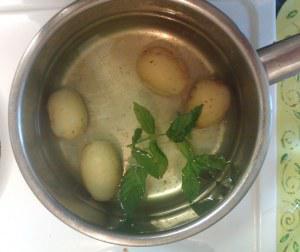
It may not be a bumper harvest, but hopefully there will still be some left in the potato bag to dig out in another couple of weeks.
I wish you all a blight free summer.

